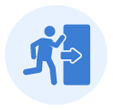Written by John Immel, Asheville, NC
Ayurvedically, a seizure may represent a kind of nervous system colic. The nervous system fires asynchronously, leading to twitching. The recovery stage resembles a reboot of the nervous system. This "reboot" takes time as all systems resynchronize. Awareness starts as a dot then expands slowly to include all systems.
Epilepsy is called Apasmara (Apa = loss, smara = memory, intelligence and/or consciousness) in Ayurveda, and classified as a vata disorder. In Chinese medicine, a seizure is related to heat in the heart.
Acute Seizure
If you see a person having a seizure, call 911 immediately. During the seizure keep head forward, lay the person on their side so they don't aspirate saliva or vomit into the lungs. Do not attempt CPR or heimlich (but check breathing to make sure they are not choking). Do not stick anything in the person's mouth.
If the seizure lasts for a longtime (15+ minutes) it can cause hypoxia if the person is unable to breathe well. At the emergency room, doctors may order various tests including an EKG, cat scan, blood test, urine test, and a neurological exam. These tests rule out causative factors. Then, they may recommend an appointment with a neurologist for further testing (EEG, MRI).
If no causative factors are found, it may be epilepsy. Epilepsy is confirmed by two or more episodes of seizures. The probability of a second seizure within one year is 25%, and 45% within 3 years. Unprovoked seizures are most common in infants and at puberty. Infection b y tapeworm (Neurocystericercosis) is the most common cause of epilepsy in many tropical countries as well as some isolated areas of the U.S.
Nonpharmcological treatment
Nonpharmacological treatment of epilepsy includes surgery, vagal nerve stimulation, ketogenic diet, and other alternative/complementary therapies, e.g., yoga, Ayurveda, electroencephalography (EEG) biofeedback technique, aerobic exercise, music therapy, transcranial magnetic stimulation, acupuncture, and herbal remedies (traditional Chinese medicine). (source: Nonpharmacological treatment of epilepsy)
Ayurvedic Approach
Please review and research the ideas below to determine their suitability for your health and wellness. Please contact your doctor before making any changes to your health and wellness.
Avoid Triggers
Keep a journal to record potential triggers.
Note time of year, time of day, what the person was doing, recent foods, and where the seizure occurred. Some common triggers include lack of sleep, stress, mirrors, and flashes of light.
Maintain a Relaxed, Balanced & Resilient Nervous System
Research the following techniques below to support the nervous system as much as possible, which may reduce the number and length of seizures.











